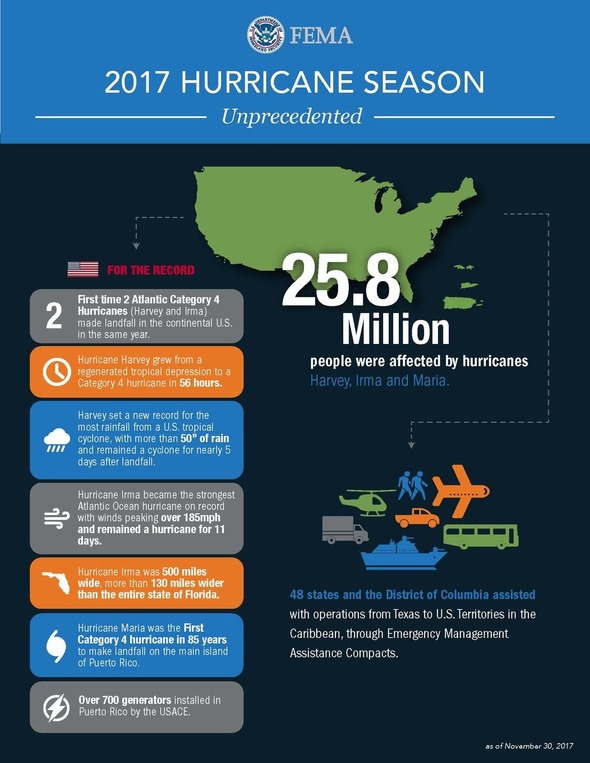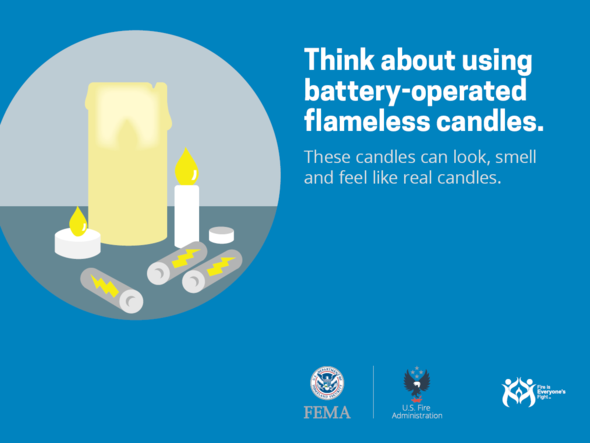|
While
November 30 marked the end of a historic hurricane season, FEMA and its partners
continue to work diligently in support of disaster survivors recovering from
the devastating season. Four hurricanes made landfall: Harvey,
Irma, Maria and Nate (the first three were classified as major hurricanes, which
affected roughly 25.8 million people).
Also during this season, nearly two dozen large wildfires burned more than
200,000 acres of land in northern California.
Hurricanes Harvey and Irma marked
the first time two Atlantic Category 4 hurricanes made landfall
in the continental United States in the same season. Hurricane Harvey
set a new record for the most rainfall from a U.S. tropical cyclone,
with more than 50 inches of rain in some areas. The storm resulted in
catastrophic flooding in Texas and western Louisiana. Two weeks later, Hurricane
Irma became the strongest Atlantic Ocean hurricane on record. Winds
peaked at 185 mph, and Hurricane Irma remained a hurricane for 11 days.
Irma was the longest-lived Atlantic hurricane since Ivan in 2004. The public response to Hurricane Irma, as the storm approached, resulted in one
of the largest sheltering missions in U.S. history.
Hurricane Maria devastated the U.S.
Virgin Islands and Puerto Rico soon after Hurricane Irma struck their shores.
Hurricane Maria was the first Category 4 hurricane to make
landfall on the main island of Puerto Rico in 85 years, and the resulting
response became the longest sustained air mission of food and water in
FEMA history. In addition to these hurricanes, prior to the 2017
season FEMA already had 17 Joint Field Offices working 28
presidentially declared disasters.
While the 2017 Hurricane Season has
ended, recovering from these devastating hurricanes will take years, and FEMA
and our federal partners will continue to support affected governments and
survivors as they build back stronger.

As
part of continuing efforts to improve the customer experience for all its flood
insurance policyholders, the National Flood Insurance Program (NFIP) recently
changed service providers for its NFIP Direct Program. Effective December 1, 2017, Torrent Technologies, which is based in Kalispell, Montana, is now
the program’s service provider.
During
a competitive contracting process which began in 2016, FEMA awarded the new
contract earlier this year. For several months, the agency has been
working with both the current and new contractor to ensure a smooth transition
and to ensure that customers see no impact to service or payment.
The NFIP Direct is designed to allow all
state-licensed property and casualty insurance agents to sell NFIP policies
to their customers. Agents have the choice to sell policies through an
affiliated Write-Your-Own (WYO) insurance company, or from FEMA itself through
the NFIP Direct. The policy coverages and premiums are the same, no matter
where the NFIP policy is purchased.
Disasters can strike unexpectedly, and emergency responders may not be
able to be on the scene right away. Life-threatening injuries require immediate
action to reduce the chances of death, and people may be able to save lives by
knowing what simple steps to take. You are the help until help arrives.
FEMA’s "You Are the Help Until
Help Arrives" animated interactive video educates and empowers the
public to take action in emergency situations and provide lifesaving care
before professional help arrives. The video is also available with Spanish
closed captioning and descriptive audio.
In the wake of recent disasters affecting the United States and
territories, the public can use FEMA’s resources to
learn what to do in cases where they may be in the best position to provide
first care to someone with life-threatening injuries. As disaster survivors
clean up and rebuild following a disaster, it is important that safety remains
a top priority. The program teaches the public how to aid those in need,
while keeping themselves and others safe. FEMA developed free tools for the public to learn more, including
materials for individuals to train others. To download the free resources,
view the animated interactive video, and find out more, visit www.ready.gov/untilhelparrives.
Additional resources
available on the UHA site include a web-based training program, and a
downloadable instructor guide plus student tools to provide in-person training.
Since the program launched in February 2017, more than 44,000
people have taken UHA training. Course feedback remains remarkably
positive. Specifically, 86 percent of training participants
surveyed either agreed or strongly agreed the course taught them valuable
concepts, and 98 percent indicated they were more likely to
help after taking the course.
The program is the result of an interagency
collaboration led by FEMA's Individual and Community Preparedness Division in
cooperation with the U.S. Department of Health and Human Services Office of
the Assistant Secretary for Preparedness and Response (ASPR), the Medical Reserve Corps (MRC), and the Uniformed Services University's (USU) National Center for Disaster Medicine and Public Health
(NCDMPH). Original research supporting the training curriculum
comes from the Centers for Disease Control and Prevention (CDC).
According to the U.S. Fire
Administration (USFA), December is the peak time of year for home
candle fires. Be
fire smart as you deck the halls for a festive holiday season with these USFA tips:
- Inspect
holiday lights each year before you put them up. Throw away strands with
frayed or pinched wires. Read the manufacturer’s instructions for the
number of light strands to connect.
- Turn
off all holiday lights before going to bed or leaving your home.
- Consider
using battery-operated flameless candles, which can look, smell and feel
like real candles.
- If
you do use lit candles, make sure they are in stable holders and place
them where you can not knock them down.
- Keep
candles at least 12 inches away from anything that burns. Never leave a
burning candle alone in an empty room.
- Water
Christmas trees every day. A dry tree is dangerous because it can catch
fire easily.
- Make
sure Christmas trees are at least three feet away from heat sources like
fireplaces, radiators, space heaters, candles or heat vents. Also, make
sure the tree does not block exits.
Find more holiday, Christmas tree, and fire safety information on the USFA Holiday Safety
page.

|